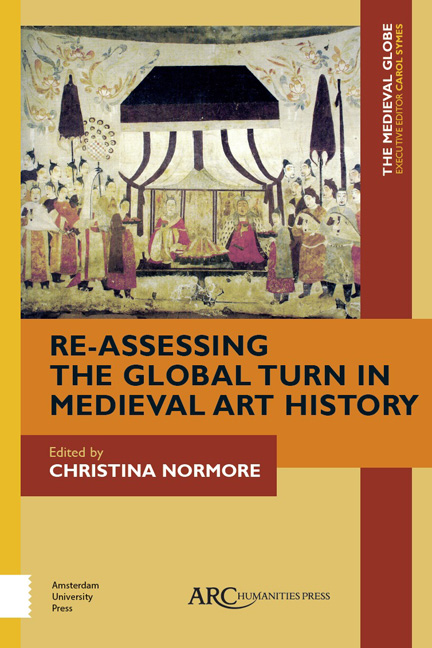Book contents
- Frontmatter
- Contents
- List of Illustrations
- Editor’s Introduction: A World within Worlds? Reassessing the Global Turn in Medieval Art History
- A Camel’s Pace: A Cautionary Global
- The Fatimid Holy City: Rebuilding Jerusalem in the Eleventh Century
- Worldliness in Byzantium and Beyond: Reassessing the Visual Networks of Barlaam and Ioasaph
- Exchange of Sacrifices: West Africa in the Medieval World of Goods
- The Beryozovo Cup: A Byzantine Object at the Crossroads of TwelfthCentury Eurasia
- Mobile Meanings: A Global Approach to a Dagger from Greater Syria
- Global Medieval at the “End of the Silk Road,” circa 756 CE: The Shōsō-in Collection in Japan
- Response: Medievalists and Early Modernists—A World Divided?
- Index
The Beryozovo Cup: A Byzantine Object at the Crossroads of TwelfthCentury Eurasia
Published online by Cambridge University Press: 23 January 2021
- Frontmatter
- Contents
- List of Illustrations
- Editor’s Introduction: A World within Worlds? Reassessing the Global Turn in Medieval Art History
- A Camel’s Pace: A Cautionary Global
- The Fatimid Holy City: Rebuilding Jerusalem in the Eleventh Century
- Worldliness in Byzantium and Beyond: Reassessing the Visual Networks of Barlaam and Ioasaph
- Exchange of Sacrifices: West Africa in the Medieval World of Goods
- The Beryozovo Cup: A Byzantine Object at the Crossroads of TwelfthCentury Eurasia
- Mobile Meanings: A Global Approach to a Dagger from Greater Syria
- Global Medieval at the “End of the Silk Road,” circa 756 CE: The Shōsō-in Collection in Japan
- Response: Medievalists and Early Modernists—A World Divided?
- Index
Summary
BYZANTIUM IS PERHAPS best known for its sacred art. Haunting icons, breathtaking mosaics, immersive wall paintings, and otherworldly ecclesiastical architecture are among the hallmarks of the tradition. Yet, as one of the wealthiest and most cosmopolitan societies of the medieval world, the Byzantine Empire also generated an impressive body of art and architecture that was used in nonreligious practices. One such object is a gilded silver cup found in the Siberian town of Beryozovo on the Ob River (now modern Russia), an area where numerous medieval artifacts have been discovered ( Plate 6.1 ). On the exterior bottom of the vessel is incised an Old Cyrillic inscription, which records its weight in a hand dated to the twelfth century. Medieval Rus’ was part of the Orthodox Christian sphere and maintained active diplomatic, trade, and ecclesiastical relations with Byzantium.While the inscription suggests that the cup arrived in Rus’ lan ds soon after its production, the vessel's form, technique, iconography, and style firmly support a Byzantine origin. Its specific region of manufacture is debated, however, with scholarly consensus split between a Constantinopolitan provenie nce and a provincial one. Nonetheless, all scholars agree that the Beryozovo cup is a work of high quality, produced for members of the empire's social elite.
The polylobed wall of the cup creates 154 repoussé surfaces on which are embossed vignettes of feasting and entertainment in the top row, and depictions of real and fantastic beasts as well as vegetal designs in the lower rows. The motifs include dancers, musicians, acrobats, harpies, sphinxes, quadrupeds, birds, and flowers ( Plate 6.2 ). These flora, fauna, and entertainers rotate around a centrally placed female figure, who is crowned and sits at a table (see Plates 6.1 – 3 ). The iconography adorning the exterior of the vessel evokes worldly pleasures, but as the cup was drained of liquid, its user would have encountered an unexpected motif on the interior bottom surface: a chased portrait of the military saint George, identified by a Greek inscription and depicted with a halo ( Plate 6.4 and Plate 6.13 detail, right).
- Type
- Chapter
- Information
- Re-Assessing the Global Turn in Medieval Art History , pp. 125 - 148Publisher: Amsterdam University PressPrint publication year: 2018



